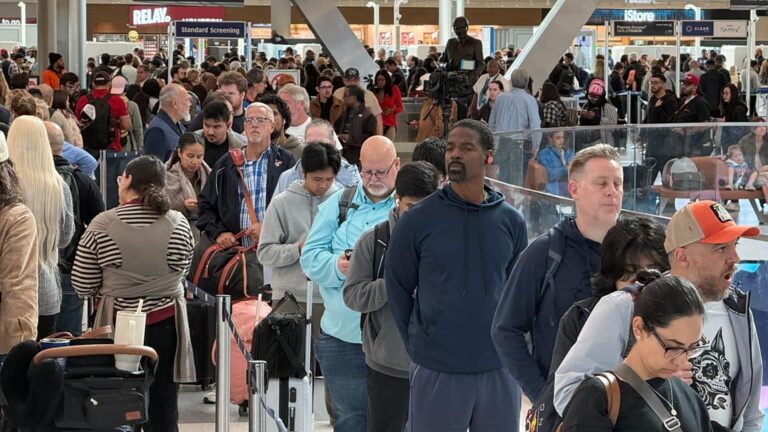How the Historic Government Shutdown Is Paralyzing US Airports
The ongoing government shutdown, now the longest in American history, has severely impacted airport operations across the nation. Federal aviation services, heavily reliant on government funding, have been drastically curtailed, leading to widespread travel disruptions. TSA checkpoints are understaffed due to halted federal payrolls, causing extensive delays that often exceed 90 minutes during peak hours. Moreover, critical functions such as air traffic control and safety inspections are operating under constrained conditions, sparking concerns about passenger safety and operational reliability.
Major operational challenges include:
- Significant reduction in TSA workforce, resulting in prolonged security lines.
- Slower customs and immigration processing at international airports.
- Postponed maintenance and safety checks on airport infrastructure.
- Increased flight cancellations and rescheduling due to limited air traffic control resources.
| Airport | Average Delay (minutes) | Percentage of Flight Cancellations |
|---|---|---|
| San Francisco International (SFO) | 98 | 14% |
| Miami International (MIA) | 90 | 11% |
| Dallas/Fort Worth (DFW) | 105 | 16% |
| Seattle-Tacoma (SEA) | 87 | 8% |
Traveler Perspectives and Safety Issues During Prolonged Airport Delays
Passengers navigating the chaos at major US airports amid the shutdown report overwhelming frustration and anxiety. Long lines, understaffed checkpoints, and minimal communication have created stressful environments, especially for vulnerable groups such as seniors, families with young children, and travelers with disabilities. Many recount experiences of waiting for hours without clear updates, intensifying concerns about missed connections and personal security.
Common passenger difficulties include:
- Queues extending far beyond terminal entrances.
- Reduced security personnel presence, impacting enforcement of safety measures.
- Limited information flow from airlines and airport officials.
- Worries about safeguarding luggage and personal items during extended waits.
| Airport | Average Wait Time | Reported Staff Shortages (%) |
|---|---|---|
| SFO | 3 hours | 38% |
| MIA | 2.8 hours | 42% |
| DFW | 2.3 hours | 33% |
Federal Initiatives to Alleviate Airport Disruptions
In response to the escalating crisis, federal agencies have launched emergency measures to stabilize airport operations. The Department of Transportation (DOT) and TSA have coordinated efforts to deploy additional staff and optimize security screening workflows. Emergency funds have been redirected to sustain critical air traffic control functions and essential safety inspections, aiming to minimize further disruptions and maintain passenger safety.
Notable actions taken include:
- Implementation of backup staffing protocols to reduce security line congestion.
- Extension of operational hours at key airport facilities to manage delayed flights.
- Enhanced communication strategies, including real-time updates via mobile apps and public announcements.
| Agency | Initiative | Outcome |
|---|---|---|
| TSA | Augmented agent deployment on high-traffic routes | Cut average wait times by approximately 30% |
| FAA | Prioritized clearance for delayed flights | Reduced cascading cancellations |
| DOT | Coordinated contingency ticketing with airlines | Streamlined passenger rebooking processes |
Practical Tips for Travelers During the Shutdown
Travelers should adopt a proactive approach to mitigate the impact of airport delays caused by the shutdown. Opting for tickets with flexible change or cancellation options can reduce financial risks associated with sudden schedule changes. Arriving at airports well ahead of departure times is essential to navigate longer security lines. Leveraging airline and airport mobile apps for live updates on flight status and gate changes can help avoid unexpected disruptions. Packing essentials such as snacks, water, and medications in carry-on luggage ensures comfort during extended waits.
For those seeking alternatives, ground transportation options like regional trains, buses, or carpooling services offer viable substitutes. Engaging with fellow travelers and airport personnel can provide valuable insights into evolving conditions and potential reroutes. Below is a summary of recommended strategies to ease travel during this period:
| Strategy | Advantages |
|---|---|
| Flexible ticket options | Reduces financial risk from cancellations |
| Early airport arrival | Minimizes stress and risk of missed flights |
| Real-time flight tracking apps | Keeps travelers updated on changes |
| Alternative ground transportation | Offers flexible travel options |
| Packing essentials in carry-on | Ensures comfort during delays |
Looking Ahead: What to Expect as the Shutdown Continues
As the government shutdown drags on, the strain on the US aviation system is expected to intensify, potentially leading to longer delays and more frequent cancellations. Industry analysts warn that without a swift resolution, the cumulative effects could ripple through the broader economy, affecting supply chains and business travel. Passengers are encouraged to stay vigilant by monitoring official updates and preparing for ongoing disruptions. Flexibility and patience will remain essential as the situation evolves.







